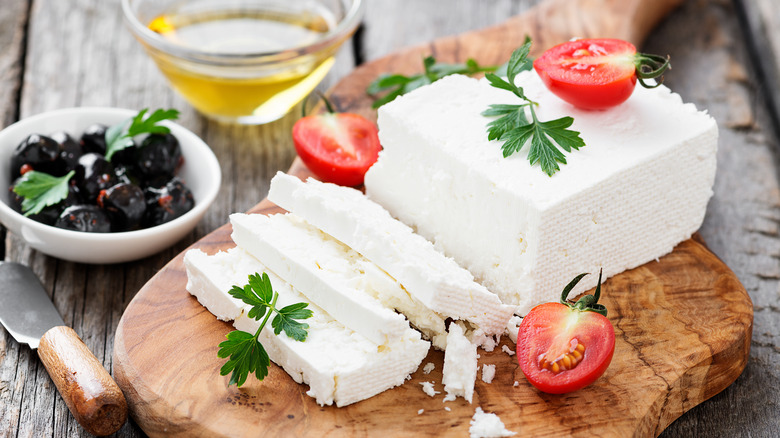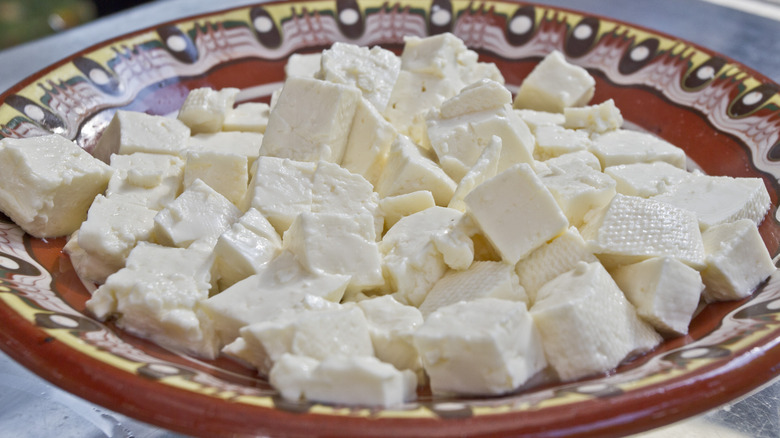The Best Way To Eat Bulgarian Feta Cheese
While the baked feta and tomato pasta might have filled everyone's social media feeds for its flavor and simplicity, feta is more than just an ingredient in a viral recipe. Although the actual Greek word feta means slice, the crumbly, salty, and creamy cheese has become a versatile ingredient in many cooks' repertoire.
According to Real Greek Feta, cheese making can be traced back to the early civilizations, but feta is a uniquely Greek offering. Similar to how certain wines or liquors, like Champagne or bourbon, require a connection to a very particular region and have strict rules regarding their making, ingredients, and creation, similar rules apply to Greek feta.
As Culture Cheese Magazine discusses, Greek feta cheese is required to be "70 percent sheep's milk and up to 30 percent goat's milk." As some cheese eaters have learned, Greek feta can have a different flavor profile than other offerings. From more pungency to less citrusy qualities, the differences can be more than subtle. When discussing this crumbly, salty cheese, feta is not all Greek, and that difference matters.
What is Bulgarian feta cheese and what is the taste profile?
While every cheesemonger has a particular recipe that creates a special flavor, Bulgarian feta cheese is different from its Greek counterpart. One style of this type of cheese is Sirene. As Cheese.com discusses, South-Eastern Europe white brined feta combines various kinds of milk to make this cheese. Goat, cow, and sheep's milk in various proportions combine together to create a slightly grainy texture cheese. With a zesty lemon-forward flavor, the bright, crumbly cheese brings a tanginess to many dishes.
Food Fun Travel Blog describes Bulgarian Feta as softer and wetter than the Greek version. While the aroma is still strong, the creamy texture seems to add an unctuous note to the eating enjoyment. Since this type of feta cheese is not regulated under the Greek parameters, the offerings can vary depending on the maker. But, for people who prefer luscious, citrus-forward flavors, Bulgarian Feta might be the ingredients to add some zest to recipes.
How to serve Bulgarian Feta Cheese
While many people have a preferred way to enjoy feta in a salad, over pasta, and in a variety of other recipes, Bulgarian Feta Cheese, Sirene, is slightly different in texture and flavor from the Greek variety. Sometimes considered the saltiest of the varieties, you can pair this cheese with soups or salads. In addition, it's tasty and can be enjoyed simply with oil, salt, and pepper.
Another option is to bake with the Sirene. Dishes like tutmanik and banitsa are popular. Banista is a traditional Bulgarian cheese pie. As 196 Flavors states, the layers of flaky pastry can be filled with sweet or savory ingredients. One version with Sirene is served on New Years and is meant to convey good luck and fortune for the future. In contrast, tutmanik, also called mesenitza, is a Bulgarian stuffed bread. While recipes vary, the round, stuffed bread is simple yet satisfying.
In the end, Bulgarian feta offers a flavor variation on the popular Greek cheese. Whether cooks are looking for a creamier texture or a citrus-forward flavor, this variety might be a slice above the rest.


